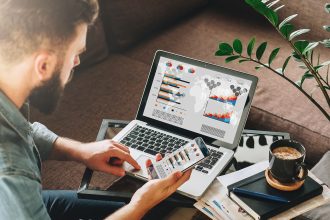AI is changing how we create visuals. It helps brands save time and money. It also boosts engagement.
A recent survey by Gartner found that 37% of organizations use some form of AI in marketing. This surge shows a clear trend. Companies want faster, more cost-effective ways to create eye-catching campaigns. AI-powered image generation delivers on that promise.
Audience
This article targets marketers, content creators, and brand managers. They face tight deadlines and fierce competition. They need better tools to stand out. AI-generated visuals can help.
These case studies focus on real-world examples. They reveal how AI-powered images drive results. They also show potential pitfalls to avoid.
Reason
Why look at these examples? Because data beats theory. We can see how brands use AI in live campaigns. We discover what worked. We learn what did not.
We also get advice from experts who tested these methods. We will explore tangible metrics like higher engagement and lower costs.
Outcome
By the end, you will have a clear action plan. You will see how AI speeds up design and raises quality. You will also learn about ethical and creative challenges. Then you can adapt these insights to your own projects.
Case Study #1 – Rapid Viral Growth Through AI-Enhanced Social Media
Challenge
A small health supplement brand struggled with low visibility. Their social media posts blended into crowded feeds. Organic reach had dropped. Ad budgets were tight. They needed a fresh strategy.
Their goal was simple: go viral with a new product launch. They needed images that popped. But they also lacked the resources for professional photoshoots.
Approach
They adopted an AI image generator. They fed it short text prompts about energy, health, and nature. The tool produced vibrant concept art. Each piece looked unique.
They tested these images on Facebook, Instagram, and Twitter. They used short captions and hashtags related to wellness trends. The AI visuals served as scroll-stopping thumbnails. They also sparked curiosity. People clicked to read more.
An in-house designer added brand colors and logos. This “AI + human” blend kept the look professional. It also cut design time in half. Normally, this process took days. Now it took hours.
Results
The brand saw a 40% jump in social media engagement within two weeks. Likes, shares, and comments spiked. Their follow count grew by 25%. Sales inquiries for the new supplement doubled. Team members reported less stress. They spent more time on content strategy instead of manual design tasks.
A marketing manager at the firm shared a key insight. “AI didn’t replace us,” she said. “It freed us to focus on messaging. We stopped getting bogged down by design backlogs.” This strategy offers a blueprint for small brands with big goals.
Case Study #2 – E-Commerce Brand Boost via Automated Product Visualization
Challenge
A mid-sized apparel company managed a huge product catalog. They faced mounting design costs. They had to produce high-quality images for each item. The website needed multiple shots per product. Each style, color, and fit demanded unique images. Traditional photoshoots ate up time and money.
They also wanted more variety in backgrounds and settings. That meant scheduling multiple shoots. They needed a solution that could scale.
Approach
They used AI to generate product images from basic templates. They started with real photos of each item on a simple white background. An AI tool then changed backgrounds and lighting. It also generated different poses for the apparel. The brand curated the best results.
The design team set simple guidelines. Product colors had to stay accurate. Brand identity had to remain consistent. They monitored each batch for quality issues. They also used a style guide to align with the brand’s aesthetic.
This approach allowed them to create a broad range of images without booking new photo sessions. AI produced thousands of visuals in a fraction of the usual time.
Results
Website traffic rose by 20% after the new images went live. Customers spent more time browsing. They saw more product angles and settings. Cart abandonment dropped by 15%. The brand also cut design costs by nearly 30%.
They measured impact on social media as well. Posts featuring AI-generated images averaged 10% more engagement. Surveys showed customers appreciated the creative backgrounds. Yet they had no idea the scenes were AI-made. This underscores the tech’s potential to blend seamlessly with real photography.
Key Lessons Learned
Lesson #1 – Balance AI Efficiency with Creative Oversight
Human input remains vital. AI-generated images can be off-brand if left unchecked. In the health supplement campaign, a designer added logos. That small step maintained brand integrity.
Machines generate ideas fast. But a human eye ensures relevance. Brand managers should review final assets. This step prevents mismatched visuals. It also preserves authenticity.
Lesson #2 – Measure ROI Early and Often
Both brands tracked key metrics like engagement, conversions, and cost savings. They didn’t rely on gut feeling. They let real data guide them.
Aim for a clear baseline. Note pre-AI performance first. After implementing AI images, track changes. Focus on clicks, likes, or direct sales. Then tweak your approach if metrics slump.
As an example, the apparel brand tested different backgrounds. Some settings worked better than others. They stuck to the top performers and dropped the rest. This lean approach maximizes results.
Lesson #3 – Plan for Ethical and Copyright Concerns
Some AI tools use broad data sets to learn. That can raise copyright issues. Always check the tool’s usage policy. Make sure you have rights to commercialize any generated images.
Transparency also matters. If your visuals are fully AI-made, consider disclosing that. In some industries, regulators may require it. This fosters trust with your audience.
Conclusion
AI-powered image generation is not a gimmick. It is a tool that delivers strong, measurable results. It saves time and money. It allows brands to scale visuals without sacrificing quality.
These case studies show real outcomes. One brand went viral on social media. Another scaled product shots for e-commerce. Both learned to trust AI while still preserving human oversight.
Want to replicate their success? Start small. Use AI for a specific campaign or product line. Monitor the data. Look for engagement spikes or sales upticks. Then refine your prompts and style guidelines.
AI won’t solve every problem. But when used correctly, it can fuel rapid growth. It can also free your team to focus on strategy. That is a win for any business, large or small.
Experiment with these ideas in your next marketing push. Follow the lessons of balancing AI speed with human creativity. Track your metrics. Stay ethical. Then watch your campaigns flourish.
With the right approach, AI-generated visuals can elevate your brand. They can engage audiences. They can spark sales. So take a cue from these success stories. Unleash AI’s power in your next campaign. Then share your results with the world.














